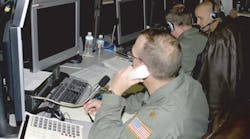By John McHale
Designers of 3U single-board computers are seeing a growing demand for 3U CompactPCI in small embedded military systems, which industry experts once considered exclusive VME territory.
3U technology, still concentrated in Germany and serving the industrial control industry, has found fans among military systems designers because of 3U's rugged size and performance advantages over 3U VME.
"We've seen a lot of interest from government people that want to replace some 6U VME cards with 3U CompactPCI ones," says Ernest Godsey, president of MEN Micro Inc. of Carrollton, Texas. "They feel they can improve performance by an order of magnitude and do it in half the space."
MEN Micro engineers recently released the F7, a single-slot 3U CompactPCI single-board computer, with Socket 370 Pentium III or Celeron microprocessor running as fast as 133 MHz.
MEN Micro is a wholly owned subsidiary of MEN Mikro Elektonik GmbH in N
"Some people shoehorn 6U VME cards into small areas that do not really have the room for that form factor," because 3U VME does not have the performance they require, he continues. Godsey says he believes that limited processing power is the reason 3U VME never really took off.
Where designers may use 3U CompactPCI in military systems is in shipboard communications, says Ray Alderman, executive director of the VME International Trade Association (VITA) in Scottsdale, Ariz. Shipboard communications, Alderman points out, are soft real-time environments, not hard real-time. 3U CompactPCI is useful for data collection because it can generate more I/O out of the backplane than 3U VME, he adds.
The main advantage that 3U CompactPCI has over 3U VME involves bandwidth and processing power, Godsey explains. It has all the processing capability of 6U CompactPCI while VME loses bus bandwidth when it shrinks from 6U to 3U, he continues.
When CompactPCI moves from 6U to 3U it maintains a J1 and J2 connector on the bottom of the card to produce bus bandwidth with 32 bits of data and 32 bits of address, Godsey says. When VME moves to a 3U form factor it has only one connector on the bottom of the card and its data bandwidth shrinks to 16 bits and its address to 24 bits, he explains.
However, 3U VME can achieve 32-bit data rates and 40-bit address rates under the VME 64 specification by mulitplexing, Alderman claims. Mulitplexing, in a sense, enables data and address to overlap; once the 16 lines are finishing running data, they can run address and vice versa, he explains.
Another big advantage of 3U CompactPCI is its flexibility. With 3U CompactPCI, users can leverage desktop technology, disk-on-a-chip systems, and strong graphics support, says Russell Scott, technical support manager at PEP Modular Computers in Pittsburgh, with worldwide headquarters in Kaufbeuren, Germany.
Currently engineers at EDO Corp. in New York are using PEP's CP302 3U CompactPCI board for the Norwegian navy, Scott says. The new CP302 CompactPCI CPU system controller has a mobile Pentium III processor with 256 kilobyte L2 full-speed on-die cache and advanced transfer cache architecture. The mobile Pentium III is passively cooled, enabling designers to deploy the CP302 in temperatures from -40 to 85 degrees Celsius.
3U CompactPCI is "a good choice in any platform that wants to run the Windows environment," Godsey says. There has been an enormous amount of interest in 3U CompactPCI among new upgrades because of the technology's link to the Wintel platform, he adds.
Microsoft Windows-based software is not designed to work with VME but it is with PCI, Alderman points out. It can work with VME by using a bridge chip such as one from Tundra Semiconductor Corp. in Kanata, Ontario. The bridge chip runs PCI on one side and VME on the other, he continues, but it does take more effort on the software side to do so.
VME does have an advantage in interrupt handling. It is more robust and needs a real-time-operating system such as VxWorks or LynxOS to keep interrupt response times at 15 to 20 milliseconds, Alderman says. Interrupt response times under a Windows operating system can run as high as 300 milliseconds, he continues.
Officials at VITA also recently produced conduction- and convection-cooled standards for CompactPCI, which improves its marketability to the military, Alderman says.
A company that has been pushing a conduction-cooled 3U CompactPCI product since last year is SBS Technologies in Raleigh, N.C., which in 1998 became a major player in the 3U market when the company acquired OR Industrial Computers GmbH of Augsburg, Germany.
The technology is a logical choice for embedded military applications because of the performance advantages it has over VME through its J1 and J2 connectors, says Wayne McGee, vice president of sales and marketing for SBS Technologies.
SBS experts recently released, the RL4, a single-slot 3U CompactPCI board that features the Motorola PowerPC 7400/75x technology with processing speeds as fast as 500 MHz, a 32-bit interface, and PCI-PCI bridging for increased application throughput.
"The RL4 CompactPCI SBC is the first product to meet the VITA 30.1 conduction-cooled standard [for CompactPCI]," says Clarence Peckham, president of the SBS Technologies Computer Group. "The RL4 is being used on production avionics platforms where the small size and PMC expansion capability allows several I/O configurations such as Mil-Std 1553 or 429 to be used in a single-slot 3U form factor."
Officials at DY 4 Systems in Kanata, Ontario, historically an exclusive VME provider are also recognizing the growing demand for 3U CompactPCI, with their release last year of a conduction-cooled, commercial-off-the-shelf 3U CompactPCI single-board computer.
Measuring only 100 by 160 millimeters, the DY 4 CompactCore 119, is for space and weight constrained systems that require high-performance processing with low-power dissipation, DY 4 officials say. The small board is for combat identification IFF transponders, digital radio, sight systems, mission computers, and electronic warfare pod-mounted boxes, company officials add. The PowerPC-based device is offered in software-compatible air- and conduction-cooled versions.
An area "where we see 3U CompactPCI as a good fit is the replacement of legacy equipment," says Duncan Young, director of marketing at DY 4. DY 4 engineers plan to include their 3U CompactPCI board in their System Technology Enhancement Program (STEP). STEP leverages open-architecture commercial off-the-shelf (COTS) product technology to fit within existing military systems that - until now - could not accommodate COTS products, DY 4 officials say.
Despite the growing demand for 3U CompactPCI there will always be a place for 3U VME, Scott says. 3U VME is a rock-solid architecture and if designers do not need the rear I/O feature of 3U CompactPCI they will stick with VME, Scott explains.
Godsey says he agrees. "3U VME will not die," he says, but 3U CompactPCI will probably generate more interest due to its processing advantages.
3U CompactPCI will not make 3U VME disappear, Alderman says. Systems that have been traditionally 3U VME such as 68k machines, will upgrade to 3U VME, because of its hard-real-time determinism and that the expense of rewriting software code for CompactPCI would be too high, he adds.
"About 80 to 85 percent of the cost of an embedded system lies in the software," Alderman says. "Code has a life of its own and lives forever."
The Germany factor
VITA's Alderman sees the concentration of 3U expertise in Germany as the result of cultural and market phenomena. Alderman used to be chief executive officer of PEP, and has extensive 3U experience in the European and United States markets.
About 70 percent or more of the 3U market for VME in Europe is in industrial control, Alderman says. "I/O density requirements are not as high with industrial control applications so they don't need 6U."
While in the U.S. there is a market for industrial control, telecommunications and the military are the primary players and want higher density I/O for the majority of their applications, he explains.
Who's Who in 3U CompactPCI
DY 4 Systems
Kanata, Ontario
613-599-9199
http://www.dy4.com
MEN Micro
Carrollton, Texas
972-939-2675
http://www.menmicro.com
PEP Modular Computers
Pittsburgh, Pa.
412-921-3322
http://www.pep.com
SBS Technologies
Raleigh, N.C.
919-851-1101
http://www.sbs.com


